Summer 2006 SST Unit in Peru
The Summer 2006 Peru unit has returned
Sat, 22 Apr 2006Welcome to the Perú SST Blog!
We look forward to using this blog to post photos and share some of our study-service-term experiences. We'll be writing more about the college students soon. For now, a little bit about us:
Beverly Lapp, associate professor of music at Goshen College. I teach piano, piano pedagogy, and other related courses. I am in my eleventh year of teaching at Goshen College.
Dale Klassen, self-employed carpenter in Goshen and co-leader here in Peru. His international experiences began at Bethel College in Kansas where he received a B.A. in industrial arts.
Greta Lapp Klassen will turn six while we are in Peru. She enjoys being called "Gretita" by her new friends at the girls' school, "Juana de Arco", just around the corner from our house.
Naomi Lapp Klassen is three years old and likes her new house with a park across the street. Her first word in Spanish was "galleta" (cookie).
These photos give an idea of what we are experiencing: our house in Lima, a view of the Pacific, Bev and the girls, Dale finding his first classic Mustang in Lima, our first serving of ceviche (it was amazing), Naomi enjoying a playground, and Greta watching paragliders.
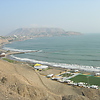
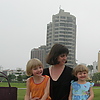
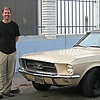

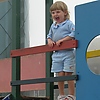
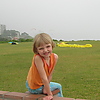
Sun, 23 Apr 2006
Introducing Celia
Here are some pictures of Celia and her husband, Oswaldo Aguirre. Oswaldo will be giving two lectures to the group: "Cultural Shock Aid Kit" and "The Role of the Evangelical Church in Peru."
These photos: Celia in the historic Gran Hotel Bolívar in Lima Central, the beautiful dome ceiling in the lobby of this hotel, Celia showing Dale the view of Lima from Cerro de San Cristóbal, and Celia and Oswaldo enjoying "mazamorra morada", a typical Peruvian dessert.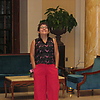
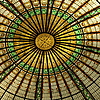
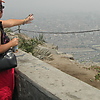
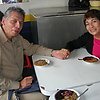
Early photos of students and families
Here are a few photos from these two events to share some faces of Peru SST 2006. In a future post weęll attempt to include a photo of each student with his or her family; they will meet for the first time this Wednesday evening.
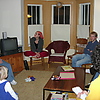
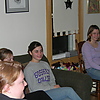
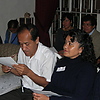
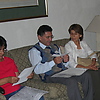
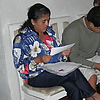
Wed, 26 Apr 2006
First night and first morning
Our next entry will introduce the students with members of their host families!

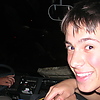
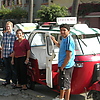
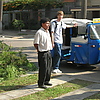
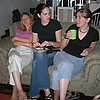
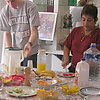
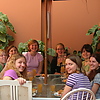
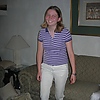
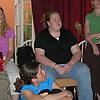
Thu, 27 Apr 2006
Introducing the students
The greetings were warm and heart-felt.
With in this post and the next, we introduce the students with at least one member of their host family.
Photos in order from left to right, beginning with the top row:
Chriss and host mother Elvira; Bethany and host sister Ross Mery; Christine and host mother Chabuca and her neice Katty; Matthew and host father Enrique; Amanda with host father Miguel and host sister Alessandra; Liz with host father Juan; Sam with host mother Betty; Greta with host father Juan and host sister Roxana with her daughter Daniela; Hannah with host mother Milagros; Christina with host parents Nelly and Luis; Kirsten with host father Fernando and host sister Vania; Jessica with host parents Victor and Leonar and their nieta.

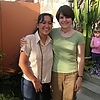
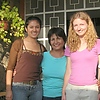

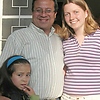
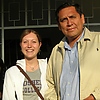
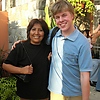
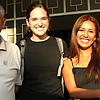
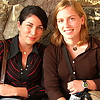
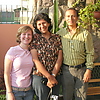
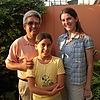
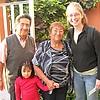
Introducing the students part two
Veloris and host mother Charo; Rachael and host mother Teresa; Kristen and host mother Edita; Karen and host mother Katia; Kyle with host mother Blanca and host brother Nicolas; Joel and host parents Walter and Malena with host siblings Isaac, Noemi, and Abraham; Dee with host parents Pedro and Julia; Marcos and host mother Debora with host siblings Ana, David, and Samuel; Anna and host mother Vicky; Gabriel and host father Jaime.
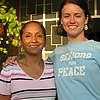
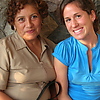
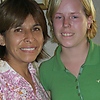
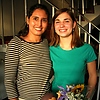
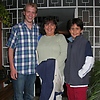
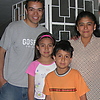
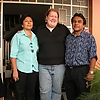
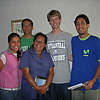
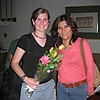
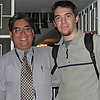
Fri, 28 Apr 2006
Lima Tour
First thing Thursday morning we met for a bus tour of Lima -- first to visit El Palacio de Gobierno. Alas, we did not meet President Toledo but we did see some interesting rooms and paintings and learned the history of the palace.
Our skilled bus driver then took us up a steep hill to a viewing point called Cerro de San Cristóbal -- a great place to see the sprawling city of Lima.
After lunch at the Lima Aero Club, a very quiet oasis from the busyness of Lima Central, we went across town to Barranco to spend the afternoon at Cenfotur, a government-owned school of tourism. Rotating conversations with Cenfotur students of English allowed for a lot of cultural exchange with Peruvians similar in age to the G.C. SSTers. After a tour of the school, we enjoyed more conversation on a patio overlooking the Pacific. We then took part in a Cenfotur cuisine class to learn how to make typical Peruvian dishes. Peru, by the way, boasts more gourmet dishes (468) than any other country in the world! (Guiness Book of World Records) The cuisine class was a very tasty way to end a busy day in Lima.
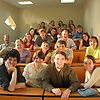
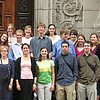
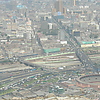
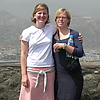
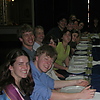
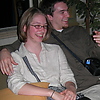
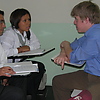
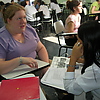
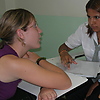
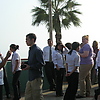
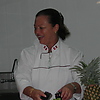
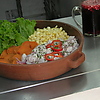
Sat, 29 Apr 2006
Odds and Ends
After lunch in various restaurants everyone found their way to Goshen Tambo for an afternoon lecture on Current Politics in Peru. Our speaker was James Plunkett, an expatriate who has lived in Peru since 1958. Jim gave us a fascinating overview of Peruvian presidential leadership over the last 50 years. We ended the lecture much more informed about the difficult choice Peruvians face in the upcoming run-off election. See the linked article for more context. While the article focuses on the three top candidates, it seems clear now that the run-off will be between Humala and Garcia.
Students are now in the midst of a 3-day weekend with their host families. Monday is a national holiday here. The weekend will provide ample time to learn to know host families and neighborhoods well. We'll be eager to see each other Tuesday morning and anticipate hearing interesting stories about various weekend activities.
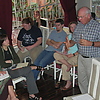
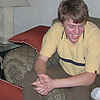
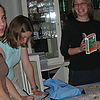
Thu, 4 May 2006
After Día del Trabajo
After Spanish classes on Tuesday morning we went by taxis to La Huaca Pucllana to visit the remains of a huge adobe pyramid from the pre-Inca Lima culture. We began with a lecture on pre-Incan civilizations presented by Pedro Vargas, historian and professor from the University of San Marcos, the oldest university in the Americas. Dr. Vargas also gave us a tour around the ruins, showing us structures that were built by the Lima culture between 200-700 A.D. and teaching us about the construction techniques, sacrificial practices, and lifestyle habits of the Lima culture.
Wednesday was our first GoshenTambo gathering. The Quechua word “Tambo” is from the time of the Incas. A "chasquitambo" in Quechua was a resting station for the Incan runners who ran messages and other items across the empire. The runner, or chasqui, would come to these resting places, or Tambos, every 15 - 20 k. along the Incan highways and byways and switch runners with the fresh one waiting to resume the journey with the message or whatever they were carrying. Our Wednesday gatherings are like a Tambo in that they are to provide a resting place and refuge from the intensity of SST. GoshenTambo includes lunch, worship planned each week by a different group of students, and time for group discussion and reflection. The sharing and singing was wonderful yesterday, and we look forward to many more enjoyable gatherings as a group.
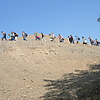
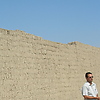
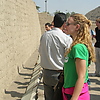
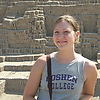

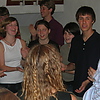
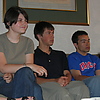
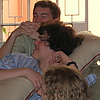
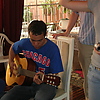
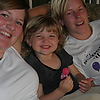
Sat, 6 May 2006
Pachacámac: Lord of the World
See the attached article to read about a fairly recent archeological find at Pachacámac!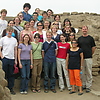
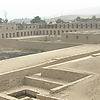
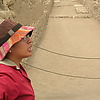

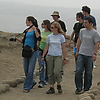

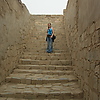
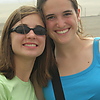
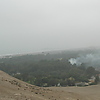
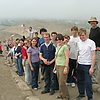
Sun, 7 May 2006
To our friends in the D.R. -- we too can have fun at the beach!
Saturday's plans involved one half of the group going to visit a shantytown in Pamplona with Dale and Milagros, host mother to Hannah. The other half went with Celia to a shantytown near Callao. Next Saturday will also include shantytown visits, and we'll write more about these soon. 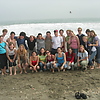
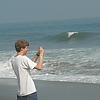
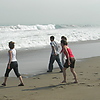
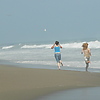
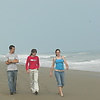
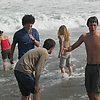
Wed, 10 May 2006
Colonial Lima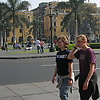
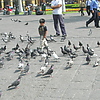
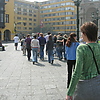
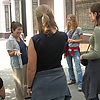
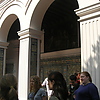
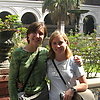
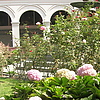

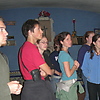
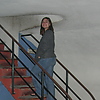
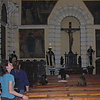
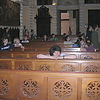
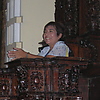
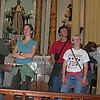
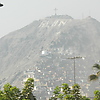
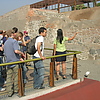
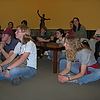
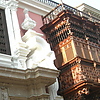
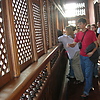
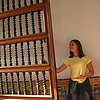
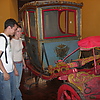
Sun, 14 May 2006
Mid-week activities
The students are divided into two groups for language classes with Professor Duilio and Professor Cesar who are trained at the Instituto de Idiomas, a premiere language school in Lima. On Wednesday we visited the main campus of this school and enjoyed meeting with students and teachers there as well as visiting the Cultural Center next door.
At GoshenTambo last Wednesday a group of students led a wonderful time of worship and discussion. Their chosen theme was awareness, focusing in on how we can be most aware of our environment and surroundings, of "God moments" that we may encounter, and of class and ethnic boundaries we experience. Sharing on these themes, singing together, and group prayer all combined for a meaningful afternoon together. We also enjoyed coffee and cake to celebrate upcoming birthdays for Matthew and Kirsten.
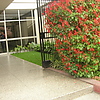
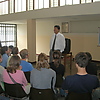
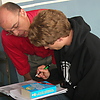

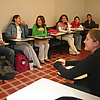
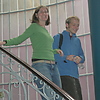
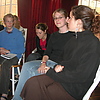
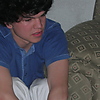
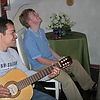
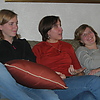
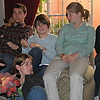
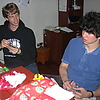

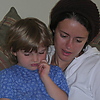
Fortaleza de Real Felipe and No Boat Ride
More waiting followed as we hoped for word that the port would still open in time for us to take the Islas Palomino tour. The fog did eventually lift that afternoon, but we decided to reschedule rather than face uncomfortably late commutes home. These are the types of "flow like water" situations that arise on SST and require patience and acceptance, possibly more of a challenge for leaders than for the students! We'll reschedule Islas Palominos and hope that Lima's unusually foggy weather for this time of year lifts soon.
Celia and I will be visiting many of the host families this term, focusing on several new families that are participating as hosts for the first time this year. As we wrapped up our day in Callao we visited with Jonny's family and are finally able to post a photo of him with them. They love Jonny and we enjoyed hearing about the joy they find in hosting his stay in Lima.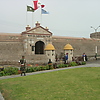
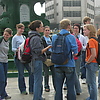
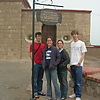
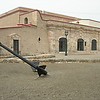
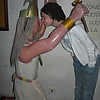
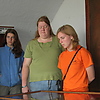
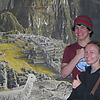
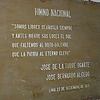
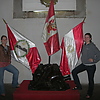
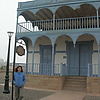
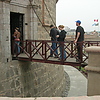
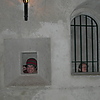
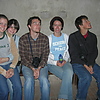

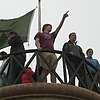
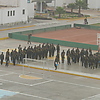
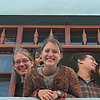
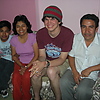
Work and Play at Pamplona
Yesterday most of the group returned to Pamplona to help with a construction project envisioned by two women leaders of this shanty town. Dale and 20 students rotated between playing with children and building a new roof to provide a shady spot outside the church. With a hammer, shovel, hacksaw, and a bag of nails they put up three woven reed mats and built a small fence to enclose the area. Rocks were gathered to continue building a small retention wall to keep sand out of the church. These pictures show the students in action, providing human ladders for each other to complete the work and enjoying the children of Pamplona (futból, foot races, singing, coloring and snacks). We are aware that our visits were too fleeting to make a real difference in the lives of the children, but adding this area of shade felt like a small "tangible" contribution.
Later in the afternoon a smaller group of students went to an orphanage in Lima run by the Asociacion Cristiana el Refugio, a non-profit Swiss-Peruvian organization. El Refugio provides a home for abandoned children and babies in Magdalena as well as a day care center for children in a shanty town area near the airport. We learned about the legal and financial challenges of maintaining these ministries, and about the hopes and dreams Doris and Lucia have for the children and families they work with. 
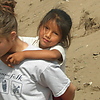
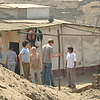
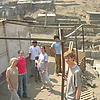
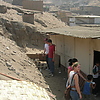

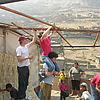
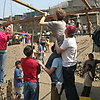
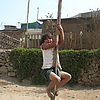
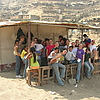

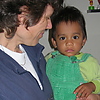
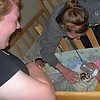
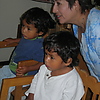
Tue, 23 May 2006
Cuzco Field Trip -- Part One
This busy week culminated in our major field trip of the term. After many carefully arranged taxi rides to the Lima airport very early Friday morning, we arrived in plenty of time for our 7 a.m. flight to Cuzco. A comfortable time of settling in at the airport turned to waiting as fog-induced delays were announced. After our 7 a.m. flight was cancelled we spent much time in conversation with airline personnel pushing to get our whole group on the next flight at 9:30 a.m. We were successful and at the Cuzco airport by 10:30 a.m. Elvis, a guide in the Cuzco area who has hosted Goshen groups in the past, met us with our bus. We were taken to a comfortable little hotel that we had all to ourselves. The owner, Manuela, had coca tea waiting for us, a natural preventative for altitude sickness (Cuzco is 10,000 feet above sea level). Sipping coca tea in the colorful roof-top dining area with wonderful views of Cuzco and the surrounding mountains was a memorable start to our time there.
After two hours of rest to help with the altitude adjustment, we began a bus tour of the Cuzco area including the famous Sacsayhuamán, an impressive Incan fortress above Cuzco that shows evidence of the amazing stone and boulder work of the Incas. Everywhere we went included gorgeous views. We ended the afternoon at Qoricancha, a site in Cuzco where the Spaniards built a cathedral on top of the sacred Sun Temple of the Incas.
From Qoricancha we walked to the Qosqo Center of Native Dance to see a folklórica music and dance show. A skilled live orchestra accompanied the colorful folk dances of a very talented troupe. Nodding (as in sleepy) heads among the group led to consensus to leave at intermission. We had a quick supper of roasted chicken, papas fritas, vegetables and sauces, and chicha morada before heading back to our hotel for an early bedtime. We had a 6 a.m. train to catch the next morning!
The next day was possibly the most anticipated day of all SST in Peru: the trip to the lost Inca city of Machu Picchu. A couple photos from the early morning train ride are included here, but you will have to wait another day to view the photos at Machu Picchu -- stay tuned.

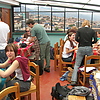
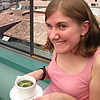
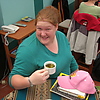

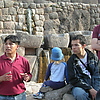

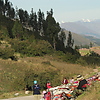
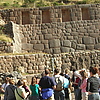
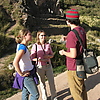
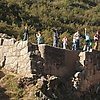
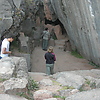
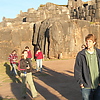
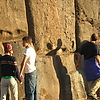
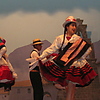
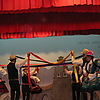
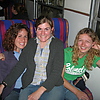
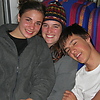
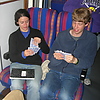
Cuzco Field Trip -- Part Two -- MACHU PICCHU
After a zigzagging climb to the “Hut of the Caretaker of the Funerary Rock” we were able to view the whole magnificent site as Elvis gave us an introduction and orientation to the various sections. We then descended for a few hours of individual and small group exploration. Photos say it all Ý we are not surprised that Machu Picchu has been nominated as one of the new seven wonders of the world. Our visit fell a few weeks ahead of peak tourist season; even with its popularity we were impressed with how unspoiled and protected a site it remains.
A four-hour journey by train back to Cuzco led us safely to our hotel where Dale, Greta and Naomi waited for us with reports of pizza on the way. Stay tuned for another post sharing photos from Sunday’s trip to the Sacred Valley.
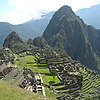
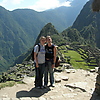

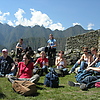

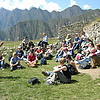
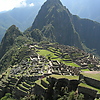

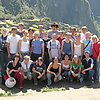
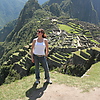
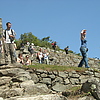
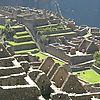
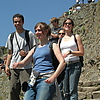
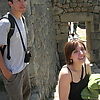
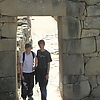
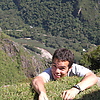
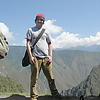
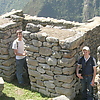
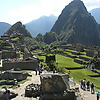
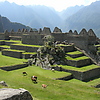
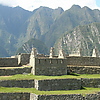
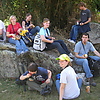
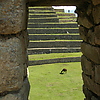
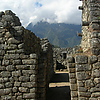
Thu, 25 May 2006
More Machu Picchu Photos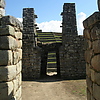

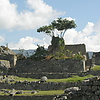
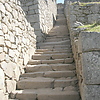
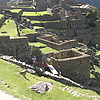

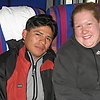
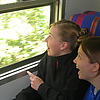

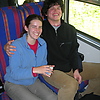
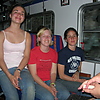
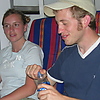
Cuzco Field Trip -- Part Three -- EL VALLE SAGRADO
We first visited the Ruins of Pisac where we enjoyed an hour hike working our way down from the hilltop Inca citadel. Criss-crossing trails and views of agricultural terracing and gorges on all sides made for a beautiful climb.
Our next stop was the Pisac Market which is one of Peru's most famous handicraft markets. By now the members of the group are fairly good at bargaining and there were many colorful items to show off as we returned to the bus.
Elvis' helpful guiding continued as we drove next to the village of Urubamba. The family of a ceramic artist named Henry provided us with an ample lunch served on beautiful pottery. Henry then gave us a pottery demonstration and we enjoyed some time to peruse his show room.
Our final drive through the Sacred Valley returned us to the Plaza de Armas in Cuzco, where we dispersed for free time to find supper and look around the center square of Cuzco. Some evening excitement occured at the hotel later that evening, with groups of students arriving in taxis to find a celebration going on: Bethany and Gabe announced their engagement. Much joy, laughter, and cake was shared among the group as we celebrated their good news. Bethany and Gabe are pictured in the second to last photo. The final photo is taken just before we said goodbye to Elvis at the airport Monday morning. Students commented that they were reluctant to leave Cuzco's beauty but eager to see their families again in Lima. 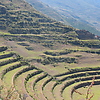
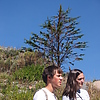
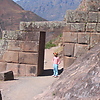
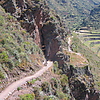
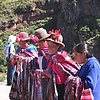
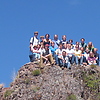
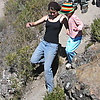
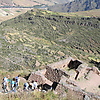

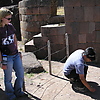
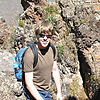
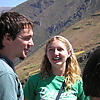
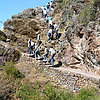
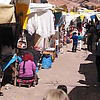
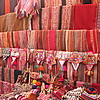
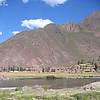
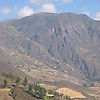
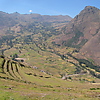
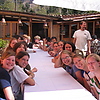
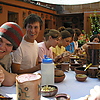
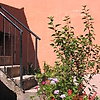
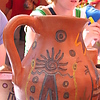
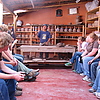
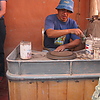
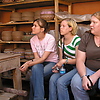
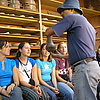
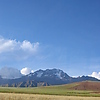
Sun, 28 May 2006
Another busy week
We had another good GoshenTambo last week with the students in charge leading a time of appreciation for what the individuals in this group and positive group dynamics add to the experience. We also enjoyed having Marg Mast from the education department at Goshen College join us at GoshenTambo and all of our activities this week. Marg will lead the Peru SST unit in summer of 2007 and was here in Lima observing this year's program. Marg and Celia are pictured in the 4th photo.
For lunch on Thursday we found "menucitos" in Chinatown, a section of downtown Lima that always offers unique views (see first three photos). Then, in connection with lectures on the influences of Catholicism and Protestantism, we visited two important places in the history of the church in Peru: The Museum of the Inquisition and the San Franciso Monastery and Church. Peru was one of the countries in which the Catholic church conducted its famous inquisition in the 17th and 18th centuries and the sights in the museum range from an amazing ceiling of over 30,000 wooden pieces to wax figures bringing to life the ghoulish torture techniques used by the inquisition. The San Francisco church, which has a courtyard full of pigeons, is most well-known for its catacombs in which there are an estimated 70,000 burials.
On Friday after Spanish classes we went back to Puerto Callao to again attempt a boat ride to Isla Palomino. This time we had no problem getting out of the port and boarded two small boats that took us to our yacht. Callao used to be a much larger city before an earthquake and tsunami reduced much of its land in the 1700s. There are three larger islands off the coast -- one is for naval training, another was a prison an ex-president of Peru actually escaped from by swimming the three kilometers to Callao, and the third is Isla Palomino. In addition to being home to thousands of sea lions, Isla Palomino is also a "guano" island. Early in the 19th century Peru was a major exporter of guano which once was up to three meters deep on the island, scraped off the rocks and loaded on to ships for export. Peru still exports guano for use in fertilizer and cleaning projects. Not sure what guano is? Check out the attached website.
Once we arrived at the Isla Palomino we viewed an incredible array of sea lions basking on the rocks, fighting for positions, and displaying all sorts of playful activity in the water. Five adventurous students (Amanda, Veloris, Christy, Karen, and Matthew) plus our guide Margot donned wetsuits to jump in the cold water and join in the play.
We eventually ventured back to land, stopping by other small islands to view the many penguins and birds that live in this part of the world.

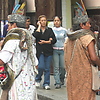
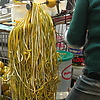
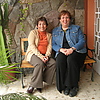
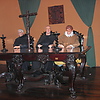
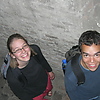
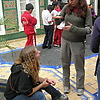
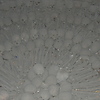
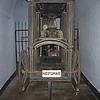
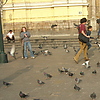
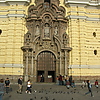
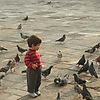
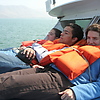

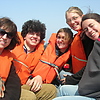
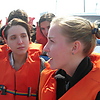
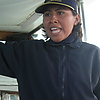
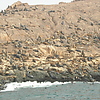
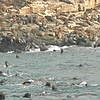
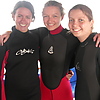
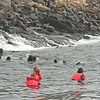
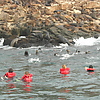
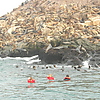
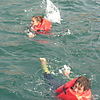
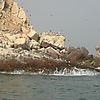
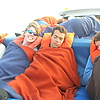
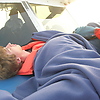
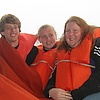
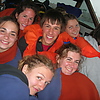
Mon, 29 May 2006
Chincha
We then found lunch in a small village close to Chincha where we chose between two different dishes typical for this region: green rice and duck or pasta with red sauce, chicken and yucca. Our next stop was a small winery where we learned about the process of wine-making (an important industry in this region of Peru) and enjoyed puzzling over exactly how grapes grow in a bottle.
The bus then took us east to a small town called El Barrio del Carmen where we hoped to observe typical music and dance of the Afro-Peruvian community. We explored the main square where some young boys tap danced for us. We thought we would need to drive back to Chincha for supper before a previously arranged evening dance show presented by a family in El Barrio del Carmen, but when we stopped by their house to confirm plans, we discovered that their schedule had changed and they could see us in ten minutes rather than in three hours! This was welcome news. Most of these pictures are from this wonderful show which demonstrated amazing precision and artistry. Students enjoyed an invitation to dance along at the end and also formed a small drum circle of their own to try some of the complex rhythms we had been hearing the previous hour.
The day-long trip ended with a stop in Barranco, a southern section of Lima where the main square comes alive with a food and music festival each Saturday night. Around midnight the students settled into a hostal near our house in preparation for an unforgettable meeting the next morning with Marie Arana, author of one of our texts, American Chica. The next post will say more about this!
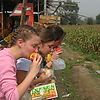
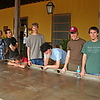

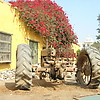
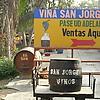

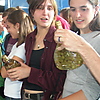
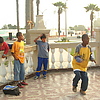
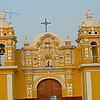
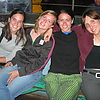
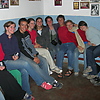

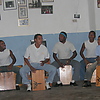
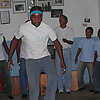



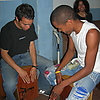
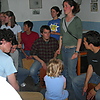
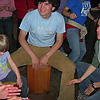
Wed, 31 May 2006
American Chica
A Brief History of Peru by Hunefeldt;
The Peru Reader, edited by Starn, Degregori, and Kirk;
Fire from the Andes (short fiction by women from Bolivia, Ecuador, and Peru) edited by Benner and Leonard; and American Chica: Two Worlds, One Childhood (Dial Press) by Marie Arana.
While all four books offer a great deal of useful information and insight, it is safe to say that American Chica is the highlight this term. You can imagine, then, how thrilled we all were that an email invitation to the author resulted in 75 minutes with her at our house on Sunday morning. Marie Arana is the editor of the Washington Post Book World, and American Chica is her memoirs about her years growing up between Peru and the United States. She responded very graciously and with humor and insight to our questions about themes from the book and other topics. Ms. Arana travels to Peru five times each year and we were honored to have this opportunity to meet her and learn from her.
Later in the day a large portion of the group went to a soccer game. Ruben, older host brother to Matthew, arranged for several of his friends to accompany the students. Host siblings to Marcos and Christy also accompanied the group. Imagine about 18 Goshen College students carefully surrounded by about 10 Peruvian bodyguards during the entire game, ensuring their safety throughout the experience. Fútbol is serious business in Lima, and no doubt the students learned some new cheering techniques to take back to G.C. soccer games in the fall.
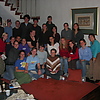
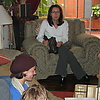
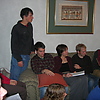
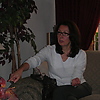
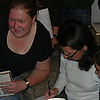
Sun, 4 Jun 2006
Highlights from Week Six in Lima
Our final week of classes focused in on two topics: the Arts in Peru and Peru's Times of Terror. With the latter we learned more about the Sendero Luminoso (Shining Path), the army's response, and ongoing effects of this painful time in Peru's history. We also visited the U.S. Embassy and were given three very interesting presentations about the political and economic sectors of the embassy, including information about U.S. A.I.D.'s work in Peru. We appreciated how openly the speakers addressed our questions.
Most of these photos are from our "arts" focus this past week. Last Tuesday afternoon we took part in a dance workshop, learning three important Peruvian folk dances. On Friday afternoon we celebrated the close of our six weeks of lectures with a lunch and show at "Brisas del Titacaca" where we enjoyed a generous meal, a live orchestra, and wonderful performances. There were also ample opportunities for the audience to take the stage and dance.
Saturday morning brought another unique experience. One of the Spanish instructors, Cesar, has been captivated by the group's singing ability, and invited us to record a CD of hymns at his friend's recording studio. We met at the studio Saturday morning and sang for two hours, recording a total of eight hymns. The CD will be called "En La Luz de Dios" and will make for nice gift items to our Peruvian friends. Special credit goes to Marcos and Veloris for their leadership in seeing the project through.
In just three days the students leave for their service assignment -- a future post will share information about where they are going and what they will be doing in the next phase of SST. Students are ready for a change of pace and scenery, and we are looking forward to the trips we'll take to visit each of them. The two final days in Lima will include final Spanish exams, a "service seminar", a final party with the host families, and a field trip to Villa El Salvador. 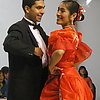
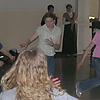
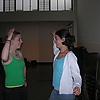

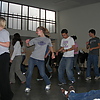
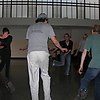

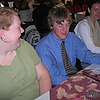
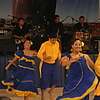
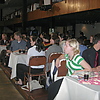
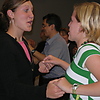
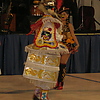
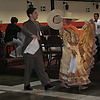
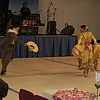
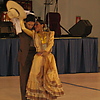
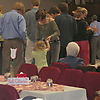
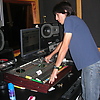
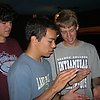
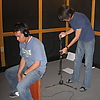
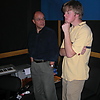
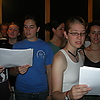
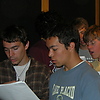
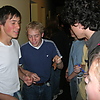
Fri, 9 Jun 2006
Family Party and Villa El Salvador
On election day some students accompanied family members to voting stations while others took part in family togetherness watching the election returns. Alan Garcia was declared winner by early evening; see the linked article from the Washington Post for an interesting perspective -- it's written by Alvaro Vargas Llosa, son of well-known Peruvian author and former presidential candidate Mario Vargas Llosa.
The family party included several tributes to the host families and people important to the G.C. program in Peru. It was interspersed with musical selections, including the student "choir" at the end. These families are quite fond of their students, and were reluctant to see them move out of Lima. The students look forward to re-connecting with their Lima host families on the weekend of July 15 when they return to Lima.
Tuesday was our last full day in Lima and we used it to visit Villa El Salvador. Here is a description of Villa El Salvador from The Peru Reader: Until 1971, Villa El Salvador was empty desert south of Lima. By 1990, African-Peruvians from Lima's decaying center and first-and-second-generation migrants from the Amazon and Andean interiors had converted it into a bustling municipality of more than 300,000, recognized internationally as the best organized of Lima's shantytowns.
We were hosted by Janet Ramirez and other staff members of Solydes, a program of social education development that helps visitors to Villa El Salvador understand the cultural forces that shaped its successes and ongoing struggles. Among the various parts of town that we visited, we were moved to stand by the grave of Maria Elena Moyano, an original settler of Villa El Salvador and activist who was murdered by the Shining Path in 1991.
Soon after the field trip the students began leaving for their service assignments. By now they have all arrived safely and are beginning to learn how they will make a contribution in their service community. The next blog will share the students' locations and work assignments.
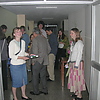
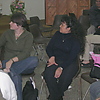
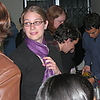
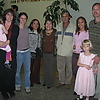
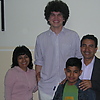
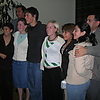
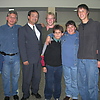
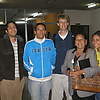
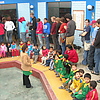
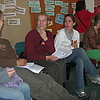

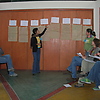
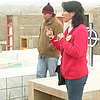
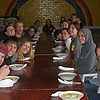
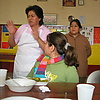
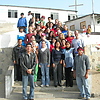
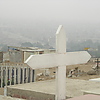
Mon, 12 Jun 2006
Students on Service
Top row:
This map attempts to highlight, with colored tabs, the regions of Peru where we have sent students: Chulucanas to the far north, near Piura (orange); not as far to the north and along the coast, Chimbote(green); to the east of Chimbote, the highlands in and around Huaraz (pink); in Lima and a couple hours north of Lima, Chancay (blue); to the east of Lima in Huancayo (red); to the south in Cuzco and Kataniray (yellow).
Gabriel Baker, art major from Indiana: service is in Tarica near Huaraz, living with a potter’s family and working for World Vision; Bethany Bauman, elementary education major from Indiana: service is in Huancayo, working at a comedor (similar to a soup-kitchen but with additional educational programs);Hannah Eash, PJCS/Spanish double major from Indiana: service is in Huancayo, working at an orphanage; Amanda Esh, elementary education major and TESOL minor from Philadelphia: Kataniray near Cuzco, working at a school;
2nd row: Elizabeth Goering, social work major from Kansas: in Chimbote helping with social services at the Los Amigos Parish; Joel Gonzalez, Spanish education major from the Chicago area: working with World Vision in Mancos near Huaraz; Karen Graber, elementary education major and music minor from South Dakota, working at an orphanage in Huaraz; Kirsten Hartwig, nursing major and music minor from Tanzania; in Chulucanas(near Piura), working at a rehabilitation center; Veloris Hess, art and PJCS major from Indiana: working for World Vision in Cuzco.
3rd row: Marcos Kuhns, computer science major from Colorado Springs: working in Caraz (near Huaraz) helping prepare video and powerpoint presentations for a variety of community development projects; Chriss Kulp,
Interdisciplinary major (Psychology, Sociology, Women’s Studies) from Virginia: working in the Los Amigos Parish in Chimbote; Jessica Kulp, nursing major from Vermont: in Cuzco working at an orphanage; Christina Leichty, nursing major from Iowa, working in Huaraz for World Vision in health care and with children; Kirsten Luginbuhl, nursing major from Ohio, working at an orphanage in Huancayo.
4th row: Rachael Meyers, nursing major from Indiana: working in health care and assisting with folk dance workshops in Caraz near Huaraz;
Christine Miller, biology major and environmental studies minor from Ohio, working at a greenhouse in Kataniray, near Cuzco; Dee Reimer, nursing major and psychology minor from Indiana, working for the medical post at the Los Amigos parish in Chimbote; Matthew Rody, physics major and music minor from Ohio, working at a greenhouse in Kataniray, near Cuzco; Greta Weaver, biology and psychology double major from Illinois,
working at a rehabilitation center in Chulucanas.
5th row: Jonny West, communications major from Wisconsin, working for World Vision in Cuzco;
Anna Yoder, interdisciplinary major (history, psychology, PJCS)from Indiana, working at a comedor in Huancayo; Kyle Yoder,
molecular biology major with music and ASL minors from Pennsylvania, working in health care in Lima; Samuel Yoder, technical theater and communication major from Ohio, working in agriculture in Chancay.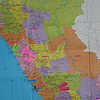
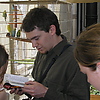
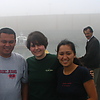
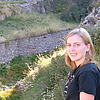
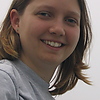
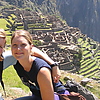
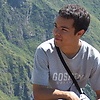
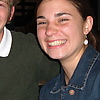
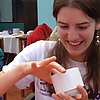
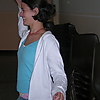
Thu, 22 Jun 2006
Chulucanas
Chulucanas is a quiet little town well-known for its distinctive ceramics. Greta and Kirsten enjoy walking to work (they think there are less than five actual cars in Chulucanas so walking and moto-taxis are the most common ways of getting around). They also enjoy the plaza that comes alive with activity each evening.
This is a new service location for the Goshen College SST program and we are fortunate that the rehabilitation center found two welcoming host families. Here Kirsten is pictured with her sisters and host Mom, and Greta with all the members of her full house. We were impressed with how well Kirsten and Greta are adjusting to a new setting, new lifestyle, and challenging work assignment. 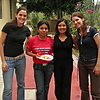
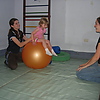
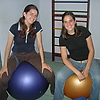

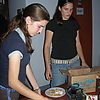
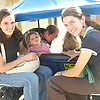
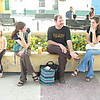
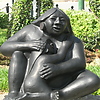
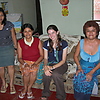
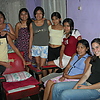
Chimbote
We were greeted by Chriss, Liz, and Dee at the Parroquia Nuestra SeĖora del Perpetuo Socorro (Our Lady of Perpetual Help Parish). This wonderful place is full of character and characters. The G.C. volunteers are enjoying learning to know the Peruvian staff and non-Peruvian volunteers, including Father Jack and Sister Peg who have each been involved with the Parish for over 20 years. During these two decades the parish has grown from a staff of six to a crew of 100 staff and volunteers at any given time. The attached website is about a support organization for the parish and gives further information.
Dee is busy working at the Parish Medical Post where she is able to help with a variety of procedures and consultations. Liz and Chriss are assisting in the social services of the Parish as well as helping at the primary school on the premises.
Host families are providing a lot of warm care and interest in the Chimbote SSTers. See the second row for pictures of Dee, Chris, and Liz with their families, including a photo of a delicious "Russian salad" provided by Liz' host mother.
Third and fourth row pictures show a variety of Chimbote sites -- the garden inside Dee's house, the rooftop view from Liz's house, a park we visited, and photos of a unique event that took place on Father's Day: area parrochial schools creating religious street art out of colored sawdust and flower petals. We found out later that towns all over northern Peru had similar events on Father's Day.
It hasn't taken long for Liz, Dee, and Chriss to become invested in the mission and people of the Parish. This is the second term that the Parish has welcomed G.C. volunteers and they tell us they want more in the future! 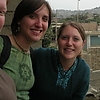
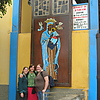
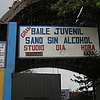
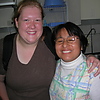
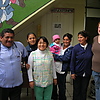
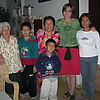
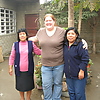
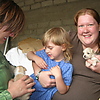
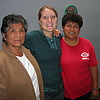
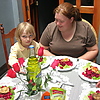
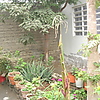
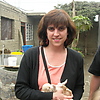
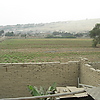
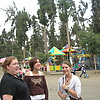
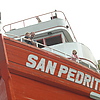

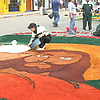
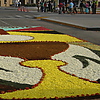
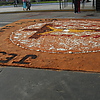
Fri, 23 Jun 2006
Huaraz and more
In the afternoon a combi took us to the small town of Tarica where Gabe is living. He introduced us to his co-workers at the World Vision regional office in Tarica. Gabe travels with World Vision personnel to surrounding villages and is learning a lot about their development projects. He also helps with office work, and as an art major he enjoys living in a home where his host dad has a pottery workshop. On his walk from office to home he encounters roaming animals and friendly faces.
Tuesday morning found us on another combi ride to the village of Mancos where Joel met us and took us to the World Vision office there. Joel and his co-workers go out into the villages most days to distribute food and health supplies. He also participates in gathering information on the health of the children and in some workshops educating mothers. We are very impressed with the work of World Vision and look forward to learning even more about it when we visit Cuzco. The linked website has more World Vision information.
Joel has a long climb to his home but once there he has an amazing view of Huascarán, the third-highest peak in South America. (Christina's and Karen's homes also boast roof-top views of Huascarán). His host parents served us mata de coca and showed us beautiful photography of the region.
We next ventured to the city of Caraz, which sits about 800 meters lower than Huaraz and feels just a bit warmer. Like the other places we visited in the Huaraz region, Caraz and its gorgeous views did not disappoint. Here we found Marcos and Rachael and after lunch visited with their host families. Rachael is working at a hospital, helping with folk dance workshops that her host mother is involved with, and teaches English. Marcos is building a database for a number of community development projects that his host father works on, and he also travels to assist with some of these projects and will be assisting in some English classes at an area school.
On Tuesday evening we had supper at the home of Ermes and Gladys, host parents to Karen. Ermes, pictured in the 2nd photo of the last row, is also the regional director for World Vision.
We met up with the entire group the next day in Huaraz to return journals and to enjoy a final meal together. After a quiet afternoon we enjoyed supper at the home of Christina before returning to Lima. While leaving the beauty of Huaraz was bittersweet, we felt lucky to have bus tickets for that night as anticipated strikes in outlying towns the following day would have made departure impossible. 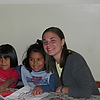
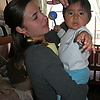
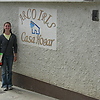
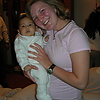
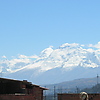
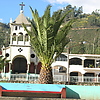
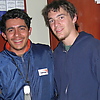
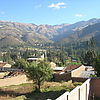
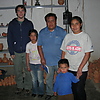
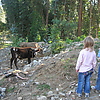
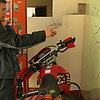
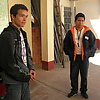
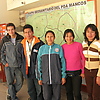
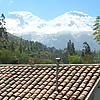

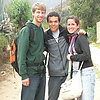
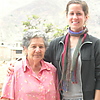
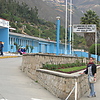
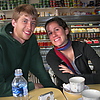
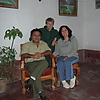
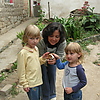
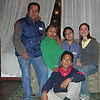
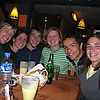
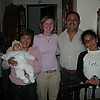

Fri, 30 Jun 2006
Kataniray
The next morning we hopped on the bus to Kataniray where Matthew, Christy and Amanda showed us around. We loved the walking opportunities that came with spending a day in Kataniray, especially since Greta and Naomi were back in Cuzco with grandparents!
Kataniray is a beautiful and tiny mountain village and home to Fundación Almeria, a non-profit organization that runs an extensive greenhouse project and primary school. Matthew and Christy work at the greenhouse while Amanda teaches in a classroom for 3-year olds. In the first photo of the second row they are pictured with Oscar Villalobos, director of Fundación Almeria.
All three are also teaching English classes to 40+ eager community children two afternoons a week.
We found supplies for lunch at two small tiendas in Kataniray, and enjoyed tuna salad on the distinctive flat bread of this region, along with yogurt and oreos for a touch of home.
Christy and Amanda share a host family, and Matthew lives down the road with another family. Both are typical Quechua homes with gorgeous mountain views and various rooms surrounding an outdoor area. Christy and Amanda have figured out that sharing a bed helps them stay plenty warm and enjoy having each other to share the unique experiences of their rustic setting. Matthew helps his host brother bring the cows home most evenings before sunset. Uno games with younger siblings, early bedtimes, and sweet coffee in the mornings have become part of the lifestyle they have adjusted to in Kataniray.
We left Kataniray as dusk settled, with admiration for how Matthew, Amanda and Christy have invested themselves in this special community.
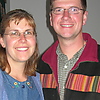
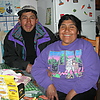
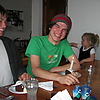
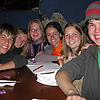
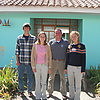
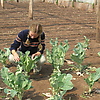
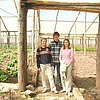
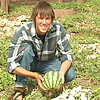
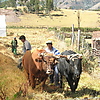
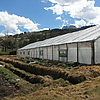
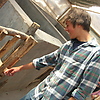
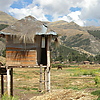
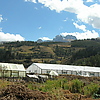
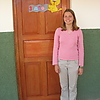
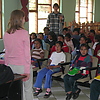
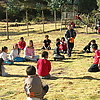
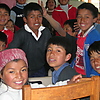
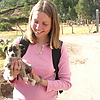
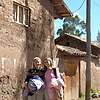
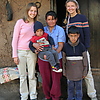
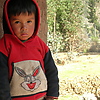
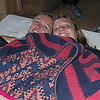
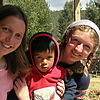
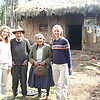
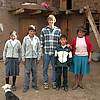
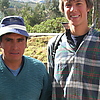
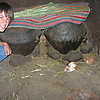
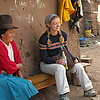
Sat, 1 Jul 2006
Cuzco
Jess is working at an Aldeas Infantiles, a privately funded organization that offers low-cost care for children, including a number of orphans who live in group homes. She is assisting a teacher in a classroom for 3-year olds -- most of the time there are 30 children in the classroom, so the work is quite demanding.
Veloris and Jonny are working for the World Vision offices in Cuzco. Veloris is using her art skills to prepare posters and flow charts that will be used in materials aimed at helping Peruvian families learn about the resources World Vision has to offer. Jonny is helping film and edit promotional materials, typically spending one week with filming in villages outside Cuzco followed by a week of editing work in the office.
Each student lives in a distinctive setting. Veloris is close to the Plaza, living with a retired artisan and his family. We enjoyed meeting Luis and Angelica and grandson Andre, "el bebe de la casa." Angelica prepared papaya juice for us and we also sampled apple pie made by Veloris.
Jess is living with a Mennonite pastor and his family; they are currently house-sitting for missionaries on leave. Her sister Bani hosted us and we appreciated the chance to rest and play with the family pets.
Jonny lives a half-hour bus ride from downtown Cuzco in the neighborhood of San Jeronimo with Valeria and Roberto (see the third picture of the previous blog), their daughter Marysol (not pictured), and grandmother (shown in the last row, fourth picture). Jonny's home is similar in design to the Quechua homes we visited in Kataniray. His mother served us carrot cake and té de manzana as we relaxed in their peaceful setting.
The Cuzco trio has no end of interesting sights to explore in their service location. In just three weeks they are already confidently finding their way around with public transportation and by now are feeling more like "CuzqueĖos" than tourists.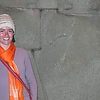
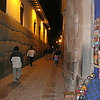
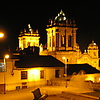
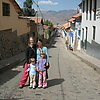
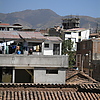
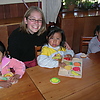
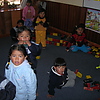
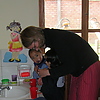
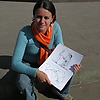
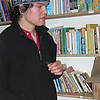
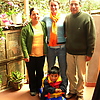
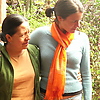
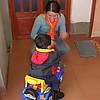
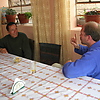
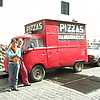
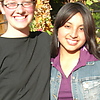
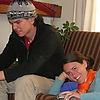
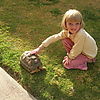
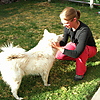
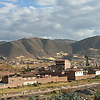

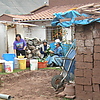
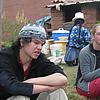
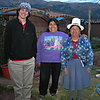
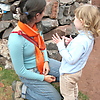
Fri, 7 Jul 2006
Huancayo
We arrived in Huancayo on Monday afternoon after a six-hour bus ride straight east of Lima. As Huancayo sits at about 10,000 feet above sea level, this was our third significant altitude adjustment in three weeks. Some rest was needed before finding Anna, Bethany, Hannah, and Kristen. We enjoyed an evening meal of roasted chicken, salad, bread, and arroz con leche in a restaurant overlooking the Plaza de Armas.
The next day began with a visit to Bethany's comedor. A comedor is similar to a soup kitchen, but also provides additional social services to women and their children. Bethany and Anna began the day early assisting other staff with food shopping, and they arrived with a truck full of staples and fresh fruits and vegetables. At Comedor Betania (coincidentally matching the Spanish version of her name), Bethany helps with food preparation and serving lunch to over 100 children. She also assists some of these children with their homework in the afternoons.
Once the truck was unloaded we piled in the back for a ride to a partnering comedor across town where Anna works. She showed us the piles of potatoes and eggs that she spends quality time peeling and chopping. "Mas despacio, Anna" (slower, Anna) is an instruction she often hears from her co-workers. Through their work at these comedores, Bethany and Anna are learning a lot about resources for the poor families of Huancayo.
For lunch we had an opportunity to sample pachamanca, a dish of meat (lamb, beef or chicken) and potatoes, beans and tamales wrapped in leaves and cooked in an underground earth oven. It was delicious and fun, though we were missing Kristen who was home in bed with a 24-hour bug.
We spent Tuesday evening and Wednesday morning on family visits, including a typical Peruvian breakfast hosted by Kristen's host mother Santosa. Note the jello Kristen is eating for breakfast (5th row, 1st photo) -- a remedy many of our students have been given for whatever ails them! The very first photo also shows off aprons that Kristen and Anna's families gave them after they expressed interest in the typical aprons of Huancayo women.
Our time in Huancayo ended with a visit to the Aldeas Infantiles (social center) where Hannah and Kristen are working. Hannah is busy with a lively group of three-year olds while Kristen divides her time between the doctor's office on site and the classroom for one-year olds. Hannah and Kristen enjoy their commute to the Aldeas which combines a substantial walk and then a combi ride to the outskirts of Huancayo where it is quiet and full of beautiful views. They are much appreciated volunteers at this busy organization that provides social services and child care for single mothers.
We left by bus on Wednesday afternoon, wondering when we would ever again experience Peru's central Andes.
We now have just two more service visit blogs to post -- Samuel and Kyle will soon be featured!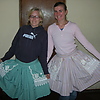
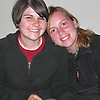
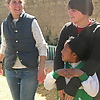
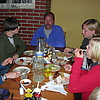
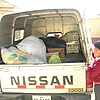
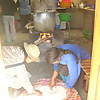
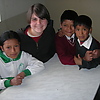
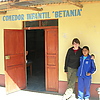
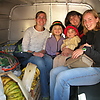
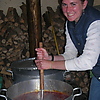
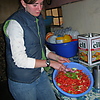

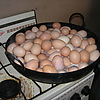
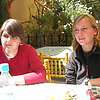
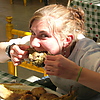
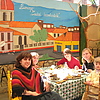
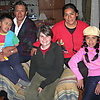
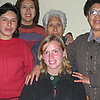
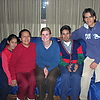
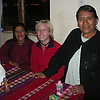
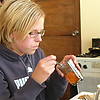
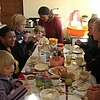
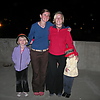


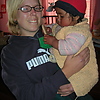
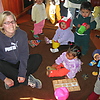
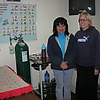

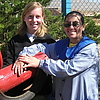
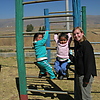
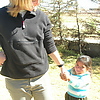
Sun, 9 Jul 2006
Chancay
In Chancay we met Sam's host mother, Hortensia, who took us out to the field where Sam and his host dad, Juan Carlos, were working. As Sam had earlier communicated to us, Chancay is a green agricultural and fishing community and the air indeed felt great. While it is usually cloudy like Lima this time of year, Sam recently enjoyed six very unusual days of hot sun.
Sam has quickly adapted to Peruvian farming techniques and enjoys comparing these to his own background as a farm kid from Ohio. After a 5-6 hour work day, afternoons have included watching the world cup with Juan Carlos and working on a story project in which Sam has interviewed most members of the SST group and several Peruvians.
Sam convinced us that no better meal is to be found in town other than what Hortensia prepares, so we accepted her invitation to lunch and what a wonderful meal it was! Peruvians are very good at hospitality, and Hortensia and Juan Carlos were no exception.
After lunch we walked along the coast on our way to the "Castle of Chancay." Built in 1924 by the great-grandaughter of Peru's first viceroy from Spain, the castle was envisioned as a home to write poetry on a cliff. It was rebuilt in 1990 by a grandson of the poetess, and Sam and Dale enjoyed touring its 40 bedrooms.
Sam has just one more week in Chancay and while he's eager to see the rest of the group, he has adjusted well to the relaxed pace of life in this quiet little city.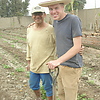
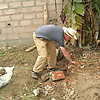
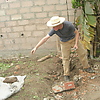
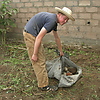
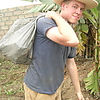
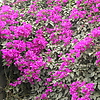
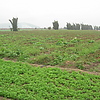
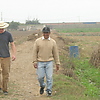
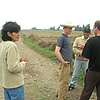
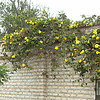
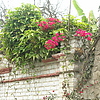
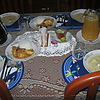
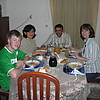
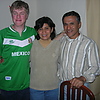
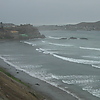
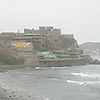
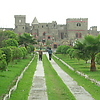
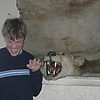
Lima
Kyle's service assignment is at a public clinic in San Juan de Lurigancho, and as a pre-med major he is finding this to be valuable opportunity. He observes and assists Dr. Veronica, one of the general practioners in this small neighborhood clinic. His final project is comparing the medical systems of Peru and the U.S. and he has enjoyed phone interviews with some U.S. doctors in addition to his research in San Juan de Lurigancho. He is learning a lot about the problems facing Lima's poor families.
A note about the fourth photo: On the clinic grounds Dale enjoyed discovering an abandoned bus that used to be a mobile birthing center.
Kyle's family has warmly hosted him and he looks forward to attending his host brother's wedding next Saturday. While staying in Lima means seeing less of Peru, he has been able to learn about this huge city on a deeper level.
As was the case with all of the students we visited, we were struck by the confidence with which Kyle showed us around the part of the world he has belonged to these last five weeks. There is a sense of things coming full circle when we think about the students' arrival in Peru in late April and all the required orientation to the ease with which they now navigate their way around their service communities and Lima.
This will be our final blog for a while. The students return to Lima next Saturday, July 15. They will spend part of the weekend with their Lima host families. We will begin a final retreat on Sunday evening before the group's departure on July 20. 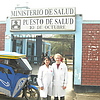
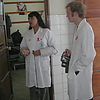
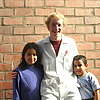
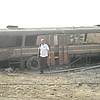
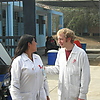
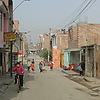
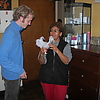
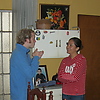
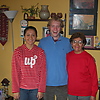
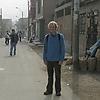
Wed, 19 Jul 2006
Final Retreat
The SSTers returned to Lima last Saturday, arriving at various times throughout the day. A few were able to see each other at our house while the whole group waited until Sunday evening for a reunion. The Lima host families were eager to host their students Saturday evening and Sunday. The group then met here Sunday evening for pizza and the requisite chocolate cake.
After a night at the Magdalena hostal followed by breakfast at our house, we left Monday morning for our final two-day retreat in Chosica, a small town just far enough east of Lima to be sunny at this time of year. It was nice to be in the sun and have a lovely yard in which to relax in-between the final exam on history and culture, final Spanish exams, and individual interviews. We also heard 23 presentations on final projects and had some group sessions to allow story-telling from service and to sing together.
Group games and plenty of time for conversation rounded out the retreat. We returned to Lima early afternoon on Wednesday to allow free time around the city before meeting up for ice-cream near the hostal. A very short night precedes the trip home with the bus picking the group up at 3 a.m. on Thursday.
Readers of the blog may be interested in the topics of the students' final projects. They worked on these during their service assignments and prepared very interesting presentations.
Gabe: ceramics in Tarica;
Bethany: the food of Peru;
Hannah: Peruvian children's songs;
Amanda: the hopes and dreams of Kataniray's children;
Elizabeth: Biodanza;
Joel: World Vision's work in Mancos;
Karen: Arco Iris Orphanage;
Kirsten: stories of clients at RBC (Rehabilitation Center);
Veloris: Textiles in Peru;
Marcos: CARE's work with the Caraz cuy farmers association;
Chriss: stories from Chimbote;
Jessica: the fruits of Peru;
Christina: the work of a comedor;
Kristen: a children's ABC book about Huancayo;
Rachael: folk dances of Peru;
Christy: the pros and cons of the eucalyptus tree;
Dee: a comparison of the Catholic and Evangelical churches in Peru;
Matthew: Adobe construction;
Greta: stories of clients at RBC (Rehabilitation Center);
Jonnie: international coverage in Peruvian news sources;
Anna: a sermon titled "Looking for God in all the Wrong Places";
Kyle: the medical system in Peru;
Sam: a story project.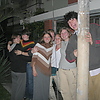
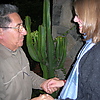
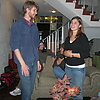
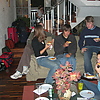
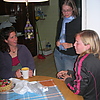
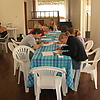
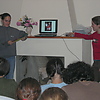
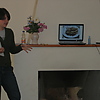
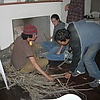
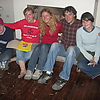
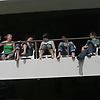
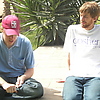
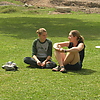
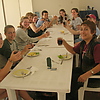
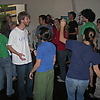
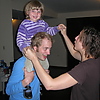
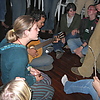
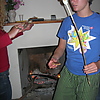

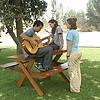
Thu, 20 Jul 2006
Linger in Peru a bit longer
From Jess, the sights and sounds of a bus ride in Lima:
Riding the bus and writing in my journal may not be very nice for handwriting Ý but it is a nice chunk of free time to “Braaziill Braazilla Brazilla!” Riding the combi in the morning to the tune of honking horns, the smell of gasoline, change clanking in the dirty hand of the cobrador Ý Lima is a city alive with sounds, sights and smells which I get a nice sample of every morning. Now that I know this route better I have a few landmarks along the way Ý some obvious, some not as much. The first one is when I leave my house Ý across the street is a children’s day care and the fences out front are all the colors of the rainbow. Then Ý as I walk down T. Marsano there is a part where it looks as though someone took a large bite out of the sidewalk. Everyone competes for the tiny part still there. I personally have only succeeded twice. Other times I had to walk through the cavernous part or wait my turn. Once on the bus, we turn onto Ejercito and there is a flower shop Ý in the afternoons it is glorious. For a while after this I generally space out until I get to Brazil. Then the best landmark of all is the gigantic Virgin Mary. She is elevated off the ground by three thick cement arms as high as about a 10-story building. Mary herself is quite tall and usually surrounded by mist in the morning, making her head disappear into the clouds. I don’t know why she fascinates me so much. I wonder what her history in this city is. On the bus there are people dressed in a variety of ways. School uniforms, uncomfortable looking heels, jeans (mine). In the morning there are men in suits sleeping, old, young Ý there does not seem to be a special kind of person or one age group that rides these buses. My morning commute is perhaps my favorite time of day. Ah ha, there is Mary now. I am going to sit back and watch her blessing on Avenida Brazil.
Jessica Kulp, May, 2006
From Marcos, some ponderings on what it takes to become environmentally friendly:
I have a hard time trying to reconcile the environmentally friendly aspects of life in Lima with the reality of their causes. Let me clarify. I’m a huge fan of public transportation. The fact that I can jump on combis and cross the entire city of Lima for a buck or less is awesome! What I struggle with is the fact that public transportation is available here only because so many people can't afford to own cars of their own. Another example: compact florescent lights are everywhere. In fact, there’s hardly an incandescent bulb in my entire house here in Lima. When I asked my host brother about it he responded frankly that florescent bulbs use less electricity. It seems that so many of the wonderful “environmentally friendly” things I like about Lima are here not necessarily because of concern for the planet, but because it really is cheaper that way. Now, if only we could catch on in the U.S. that saving 50 cents on incandescent light bulbs at the store will cost you more on your electric bill in the long run. Or even better, that compact urban living can enable cost-effective public transportation that is easy and quick. Oh yeah, and do we really need a 64 oz drink and 10 ply napkins with every meal? I wonder if lack of economic means is the only true way of getting humans to live simply. It sometimes seems that it’s just human nature to expand and consume (or waste) as much as money will allow us. I’m going to have to try to watch my wastefulness when I get back to the US.
Marcos Kuhns, June, 2006
From Hannah, a story from service:
“Dios me dice que tienes una corazón hermosa. God tells me you have a beautiful Heart. That your heart sympathizes with those in need. God has a plan to use you. Because of who you are, God will take you to places and show you places where there is a need for love. You will see difficult things Ý disfigured bodies, great disabilities, and much need, but you will be used to bring peace where there is none. It is no mistake you are studying what you are Ý you have chosen it because God knows you.”
That is more or less what I heard Miriam say as she took my hand in her slightly shaking hands. She went around and did the same to each woman in the room before resuming her knelt prayer position and continued to pray aloud with a bit of unrecognizable words mixed in that I can only assume was speaking in tongues.
Each Wednesday night there’s a small group of women that gather in one of the rooms off our courtyard to have a little worship session. This is the first time I was specifically invited, so I went. Miriam again told her story about God telling her I was coming, then there was some scripture, a short sermon, song, and the prayer time began while Edith kept a quiet song going with her poorly tuned guitar. I listened at first, then started to pray myself since each person was. I prayed that we (the students here, but mostly speaking for me, I guess) could find God. That God would guide us as we search and lead us to a place in our relationship with God that we can feel good about. That’s about when I felt Miriam’s hands on my head.
She also mentioned in the opening prayer a thanks for me, a gift from God in the flesh. I felt that pressure again. That feels like a title I’m not up to bearing.
I was touched by her words for me. What she said about going to places where love is clearly lacking and being a good presence there felt like what I would like to happen where I am now.
Then there’s the situation that many PJCS (Peace-Justice-Conflict-Studies) majors find themselves in Ý what really am I going to do with this? I don’t really know. I think too that one reason I was frustrated with myself when things were difficult here on service was that I felt like it cut down my options more. I think I had expectations for myself because of what I study and the kind of work I want to do Ý with injustice Ý that takes patience, endurance, adaptability, all that stuff. Even before, I think I knew that I will/would never be able to do anything meaningful by myself, but then when I was so distraught by how things were going, I really started to pray. Mostly for a change of attitude Ý it felt too big for me to change alone.
It’s good to think that maybe I really do have God’s support in all this vague idealistic PJCS stuff, and I don’t really have to have a great concrete plan laid out for the future.
Hannah Eash, July, 2006
The students are back in the U.S. now and we already miss them! We so enjoyed learning to know this wonderful group of young people. As they begin their re-entry and we prepare to leave in a few days, we thought blog readers might enjoy some journal samples. With their permission, we're sharing these short essays by Jess, Marcos, and Hannah. These are representative of the types of journaling each student did on SST: 1. Descriptive journaling about what they saw around them; 2. Reflective journaling about "how things work" here in Peru; and 3. Storytelling that often led into pondering about vocation and purpose.
Sun, 23 Jul 2006
Goodbye Peru
We will miss this beautiful and interesting place and look forward to following the blogs of future SST groups in Peru.
To all the readers of this blog, thank you for your interest!
Que le vaya bien,
Bev, Dale, Greta and Naomi
We are leaving in a few hours on a midnight flight out of Lima. Today we enjoyed a final lunch with Celia and Oswaldo and the Independence Day parade in Miraflores. Now a little more packing, perhaps some naps, and we'll be off.
![]()
International Education Office
Kevin Koch
kevinak@goshen.edu
+1 (574) 535-7346